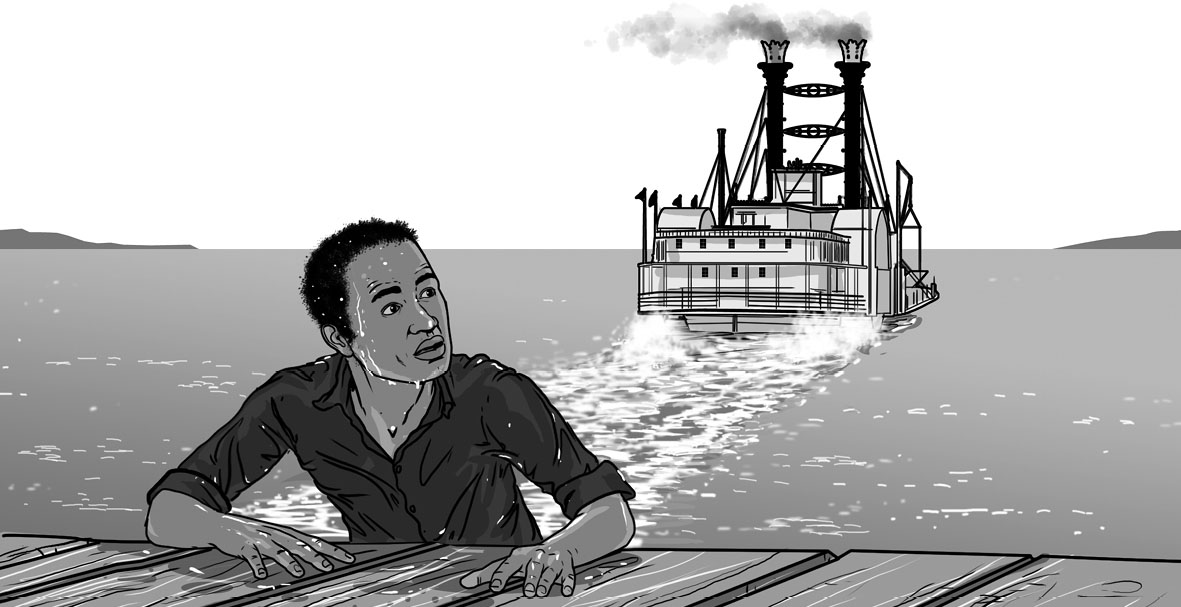CHAPTER 4
Traveling the River
The Louisiana Purchase brought many changes to the United States. Settlers traveled west on land and water. Along rivers like the Ohio, boats filled with people from the Northeast made their way to the Mississippi. Travelers from Georgia, South Carolina, and other Southern states came by way of the Gulf of Mexico to reach the Mississippi. New immigrants arrived from Europe. Some crossed the river and continued even farther west into the newly bought land. Others built homes along the banks of the river. Small towns appeared and became bigger. In time, cities arose.
Travel along the river began to change, too. Swift currents had always made traveling downriver easier and faster than going up the river. Early settlers had used homemade rafts and other flat-bottomed boats. They floated furs, flour, pork, and other goods quickly downriver where they would be sold to Indians. But the return upriver, which went against the current, was often impossible for these vessels.


By 1800, keels, broadhorns, and other barges filled with coffee, sugar, cotton, logs, potatoes, lumber, furniture, and animals managed to get upriver, but it wasn’t easy. Men pushed long shoulder poles along the bottom of the river to keep the boats moving, or pulled them forward from the riverbanks with strong ropes.


Robert Fulton
Many round-trip journeys from the Upper Mississippi down to New Orleans and back took nine months. There had to be a better way to travel north against the current.
In 1807, a man named Robert Fulton built a new kind of wooden boat. Fulton’s boat, called the Clermont, was powered by an engine fueled by steam hot enough to turn paddles on the side or back of the boat.
Some people called his boat “Fulton’s Folly.” (A folly is a crazy idea.) Others thought it would change river travel forever. They were right.
In 1811, a steamboat traveled along the Mississippi for the first time. Called the New Orleans, Fulton’s newest boat began its journey in Pittsburgh, Pennsylvania. It traveled down the Ohio River and entered the Mississippi near Cairo, Illinois.

As it headed south to New Orleans, Fulton stopped from time to time and turned the boat around against the current. The boat moved upriver easily. No poles or ropes needed! From then on, a round-trip down and up the river would take about forty days instead of nine months.
Soon Fulton’s new boat was shuttling back and forth between New Orleans and Natchez, Mississippi. Crowds gathered and hopped aboard at cities in between.
Shipbuilders in the East, especially in Pittsburgh, built more and more steamboats for passengers, as well as cargo. By the 1840s, boats overflowing with lumber, flour, corn, apples, and animals were making their way down the Ohio River to the bustling new Port of Saint Louis. Cotton, tobacco, whiskey, and other cargo was moved from the East along Southern rivers into the Mississippi and down to the Port of New Orleans.
Cargo was stored on the open lower deck. So were poorer passengers who were squeezed in between crates of vegetables, smelly livestock, and hot boilers. They brought their own food and slept on bales of cotton or sacks of grain.

Upstairs, the first-class accommodations were very different. On many boats, passengers who could afford the higher fare slept in fancy private rooms. Women dressed in expensive gowns. Men wore suits. They were served fine food and whiskey in beautiful dining rooms.

It didn’t take long for word of these “floating palaces” to spread through cities along the Lower Mississippi. Everyone, it seemed, wanted to catch a ride to Memphis, Tennessee, where they could listen to street music that would later be called the blues. Others stayed aboard, gambling all the way to New Orleans.

Often, there were professional gamblers among the passengers. Many boarded in New Orleans and rode upriver, cheating money out of rich passengers. Furious victims complained, but river pilots had something important to attend to: the safety of their boats.
Pilots on the first steamboats had to learn how to avoid huge floating logs and branches, piles of sand—called sandbars—that had been formed by the currents, broken tree limbs, and pumpkins, timber, and everything else that had fallen off floating rafts. At first, collisions with other boats were common.
There were dangers aboard the boats as well. Open furnaces could spew cinders onto cotton bales and barrels, setting the wooden decks on fire. If the steam in boilers was too hot, it caused explosions, sending boat parts and passengers into the air.

Riding the River to Freedom


Steamboat races were common, and also risky. Which boat would get to the next city first? Gamblers on the ships and along the riverbanks placed bets. Passengers begged the pilots to add more fuel and speed up. Push it harder, move it faster until sometimes, instead of winning, the pressure of the steam in the boiler caused a giant explosion.
By 1900, oil and coal had replaced wood fuel for the most part. There were fewer fires and explosions. Safety laws were passed. Steamboat races were no longer allowed. There were new laws about overcrowding and gambling. Many were pleased with the changes and the fact that boats became ever more luxurious. But others pined for the good old days, when riding the river had been dangerous and exciting.
The Natchez and the Robert E. Lee

By the 1930s, the steamboat era was coming to an end. Railroads tracks snaked all over the United States now. It was easier to move freight by train. Before long, only tourists rode steamboats on the mighty Mississippi. They still do to this day.
